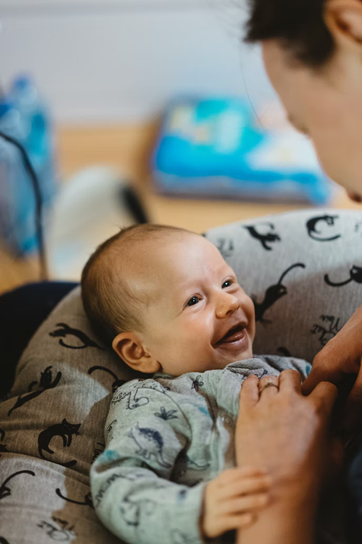13.3.2: Strategies that Support Language Development-Turn-taking
- Page ID
- 140678
Turn-taking
Infants spend much of their awake time in face-to-face interactions with their caregivers and it is this face-to-face conversational setting that provides an important context for infants to start acquiring language. Additionally, before infants acquire language they start to interact in social exchanges with caregivers characterized by turn-taking patterns, such as peek-a-boo games and give and take interactional sequences (Bates, Camaioni & Volterra, 1975; Ratner & Bruner, 1978; Rochat, Querido & Striano, 1999). These mutually engaged interactions can consist of behaviors in multiple modalities such as vocalizations, gazes and smiles. Conversational turn-taking is important during infancy as it lays the foundation for the flow and pattern of interactions, but continues to be important throughout toddlerhood and the preschool years as the amount of turn-taking children and caregivers engage in is related to language development and brain function (Donnelly & Kidd, 2021; Romeo et al., 2018, 2021). [1]

There are many ways caregivers can engage in turn-taking with children. Questions are a common way to start back-and-forth conversations (Gilkerson et al., 2018; Rowe, Leech & Cabrera, 2017). Questions can have many formats (Wasik & Hindman, 2013), including open (involving no single correct answer and likely requiring multiple word response) or closed (single correct answer), with the latter including label questions (What’s this called?) or yes/no questions (Is this a dog?). There is extensive evidence that questions in the classroom are a powerful tool for eliciting child language and fostering conversation. Open-ended questions may be relatively rare, representing approximately only 5% of caregivers’ prompts (Davis, Torr & Degotardi, 2015; Siraj-Blatchford & Manni, 2008). Interestingly, Kidd and Rowland (2021) found that, with two and three year olds, when presented with conversational opportunities, children contributed just about one-third (37%) of the turns. Caregivers can try to increase the number of turn-taking exchanges during interactions by talking about abstract, non-present concepts (Leech & Rowe, 2021). [3]
[1] Hilbrink et al., (2015). Early developmental changes in the timing of turn-taking: a longitudinal study of mother–infant interaction. Frontiers in Psychology, 6, 1492. CC by 4.0
[2] Image by Marcin Jozwiak on Unsplash.
[3] Hindman et al., (2021). Understanding child-directed speech around book reading in toddler classrooms: Evidence from early Head Start programs. Frontiers in Psychology, 12, 719783-719783. CC by 4.0

